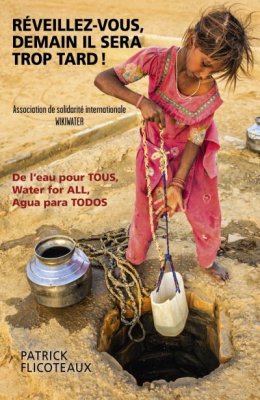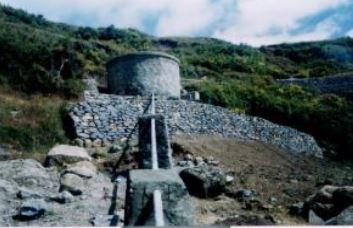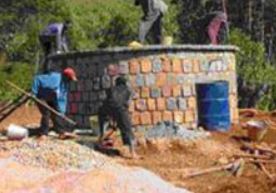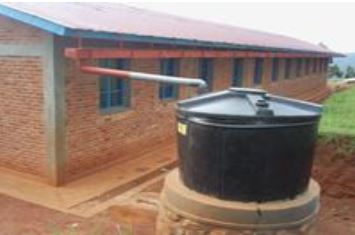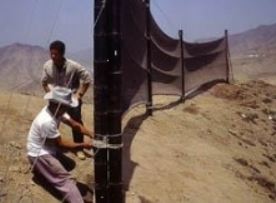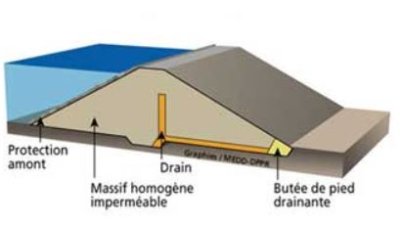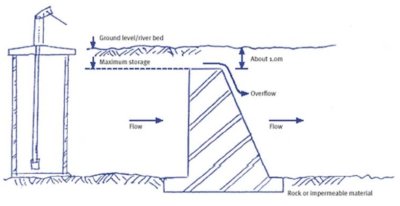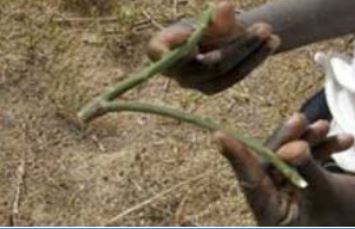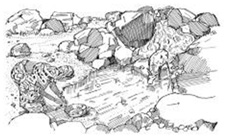
1) What is involved ?
Obtain quality water by drawing from a spring.
2) Why use this means ?
Because it is a process that is simple as well as inexpensive that has been used since ancient times and makes it possible to obtain pure water, near and easy access, and most often free of charge. The catchment of springs can also be more elaborate and associated with the construction of a mini-network for water distribution serving via gravity one or several villages that are far from the catchment site.
3) Who is primarily concerned ?
These are mostly inhabitants of rural mountain villages or underprivileged areas, but also average-sized towns when springs can be found.
4) What does this process involve ? How is it used ?
There are 3 main methods for the catchment and arrangement of a spring : a simple method, and another more elaborate one if adding a reservoir is desired and a last one for drainage.
The choice for the method depends on the characteristics of the spring (location, flow, extent, consumption to be satisfied). If its emergence is very precisely located and not deep (less than 2m) and if the planned consumption is less than the flow of the spring, the simplest method described here will be used. If a similar case is encountered but with a flow that is less than that needed for consumption, a reservoir must also be built. Finally, if the emergence of the spring is diffuse (wet or swampy land, for example) or deep, drainage must be provided upstream of the spring.
Here, we will cover only the simplest case. For the two other cases, please refer to the other data sheet "Spring catchment and arrangement with Reservoir or with Drainage".
a) The simple method, the most common
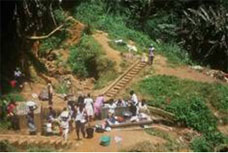
Spring catchment in Cameroon Photo Ch.Le Jallé PSEau PSEau
It can be applied if the spring emerges easily on its own with a sufficient flow.
The process generally comprises 5 steps :
- the first consists, after having conducted studies beforehand on the land, purity of the water, flow, consumption and expectations of the population, in cleaning, brush clearing, weeding, earth removal and crushing down to the impermeable layer of the ground, with the assistance of the population, the perimeter of the spring.
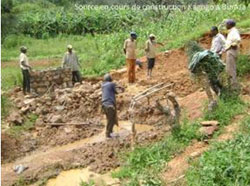 - the second has for purpose to gather the streams of water into a well or capture box. A trench is dug in order to recover the water a little further away so that it does not become polluted in contact with the last layers of land that it passes through. This trench is then filled with large rocks or stones that filter it and allow the water to flow easily. Once the filtering has been carried out using gravel, one or several drainage pipes are attached to the end of the trench and a blockage wall at the exit is created using clay or concrete. The capture box is then covered with mortar. The seal should be carefully provided for using a layer of clay or a plastic tarp, or better yet, both.
- the second has for purpose to gather the streams of water into a well or capture box. A trench is dug in order to recover the water a little further away so that it does not become polluted in contact with the last layers of land that it passes through. This trench is then filled with large rocks or stones that filter it and allow the water to flow easily. Once the filtering has been carried out using gravel, one or several drainage pipes are attached to the end of the trench and a blockage wall at the exit is created using clay or concrete. The capture box is then covered with mortar. The seal should be carefully provided for using a layer of clay or a plastic tarp, or better yet, both.
- the third concerns creating the exterior structure of masonry for the drawing location, and of a concrete slab so that the spring does not turn into a quagmire.
- the fourth consists in protecting the structure, the location and the catchment area (covering the capture box with a layer of soil and grass, enclosing the basin, setting up a protective gutter on top and around the spring of in order to intercept runoff flows and the digging of a small channel to remove unused water) as well as making arrangements, for example by providing small areas for washing nearby in order to facilitate the work of the women
- the fifth consists, after having checked the maintaining of the purity of the water after work, in making sure that the population has correctly assimilated the notions of hygiene that they received and that the management committee or the community structure to whom the spring is given to has the required skills and has taken the measures required to monitor and maintain the spring in good condition.
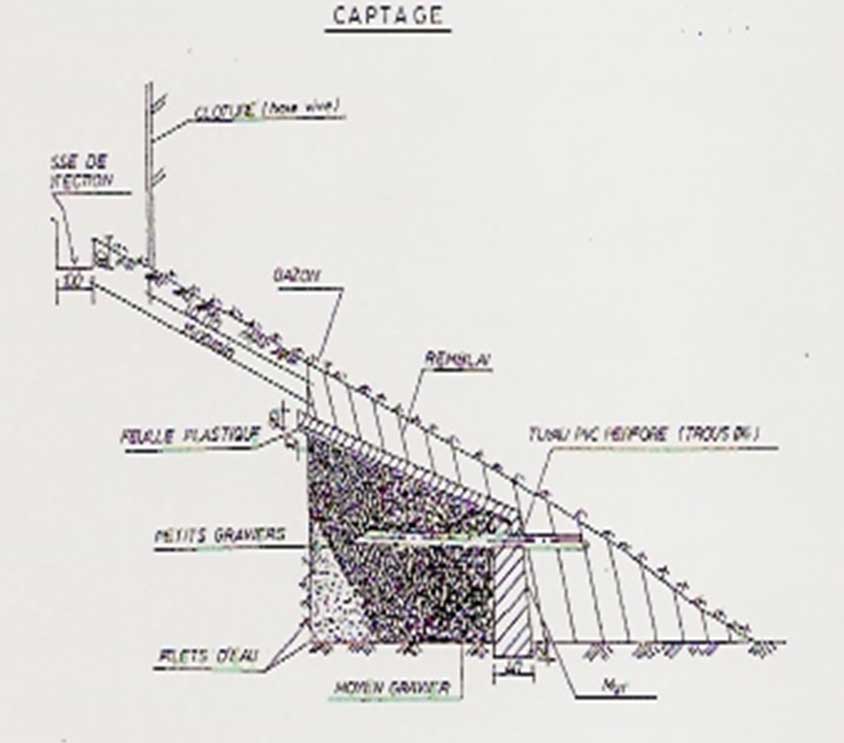
Catchment and arrangement of a Spring in Burundi (Drawing and photos : Caritas) 
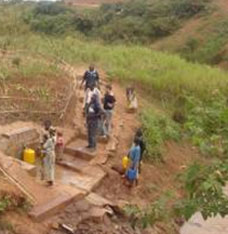 |
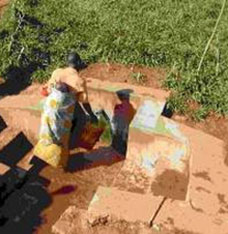 |
5) Precautions to be taken
- Maintenance for the site developed as such must be provided for, especially by defining a safety perimeter around it in order to protect it from all types of pollution (fertilizers, animal droppings) that would pollute the water collected. Possibly, in order to protect the facility from erosion, diversion ditches for runoff flows must be installed.
- The quality of the water must be checked before and after the work, and then periodically.
- The level of water in the collection basin must always be under the level of emergence of the spring before the beginning of the work, otherwise the water from the spring will no longer be able to be collected. It is therefore more prudent to also provide an overflow pipe at the exit for the basin Checking purity
- The population should be closely involved in choosing, creating and in monitoring the spring
6) Main advantages and drawbacks
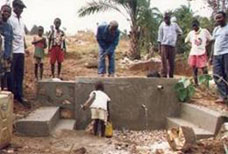 a) Advantages
a) Advantages
The water collected is generally of good quality and can be consumed directly.
The water points used are often traditional supply points that are known to the population (no change in habits, facility and safety of use)
The water usually has a regular and perpetual flow, which must be ensured beforehand, but there may be substantial seasonal differences in the flow.
The cost for construction is modest. The structures are sustainable as long as there is a minimum of monitoring.
b) Disadvantages
The flow of the spring can be irregular or seasonal.
The water runs permanently and is lost if it is not stored or diverted to a mini irrigation or water distribution system. The spring may be too far from the village.
7) Cost
The cost varies according to the location and the characteristics of the spring, but a few examples will provide a general guideline. It is generally, unless there are complications, much less than €1000.
As such, in DRC the average price (including management costs and costs for hygiene awareness but with practically free labour from the population), springs outfitted by CARITAS were €670 for the first programme of 515 springs. For the programme in progress concerning 660 springs, where substantial efforts are being made in training the population and management committees, it is €810.
Another example, but in BURUNDI : the average cost for 143 springs currently being outfitted and provided with laundry trays by CARITAS is €620, excluding management and training costs. The cost for creating a complete 6-km mini-network for distributing water created using a spring with purge chambers, reservoirs and fountains within the framework of the same programme stands at €47,700. Rehabilitating 3 other networks with an average length of 12 km costs however on the average only €16,000. The low maintenance costs will be covered by a participation of the population of about €0.07 /m3 for the beneficiaries of the connection and a lump-sum for the others.
8) Achievement examples
CARITAS Programmes in the Democratic Republic of Congo and in Burundi
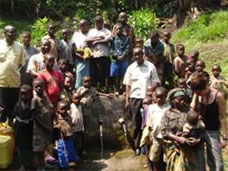 1) In DRC, in Kivu, Caritas created between 2008 and 2010, with the assistance of the European Union, a programme for collecting and arranging 660 springs, as well as awareness concerning hygiene and management benefitting 44,000 families that were uprooted by belligerents and were as such able to resettle in their villages (cost of €534,000). It is finishing another programme for outfitting 515 other springs through co-financing with the Ministry of Foreign Affairs (€345,000)
1) In DRC, in Kivu, Caritas created between 2008 and 2010, with the assistance of the European Union, a programme for collecting and arranging 660 springs, as well as awareness concerning hygiene and management benefitting 44,000 families that were uprooted by belligerents and were as such able to resettle in their villages (cost of €534,000). It is finishing another programme for outfitting 515 other springs through co-financing with the Ministry of Foreign Affairs (€345,000)
2) In the province of Gitega in Burundi, Caritas in 2010, with the help of SEDIF (Water Syndicate of Ile de France) executed a programme for outfitting 143 springs, creating or rehabilitating four drinking water distribution networks (a total of 42 km), benefitting 48,000 people and the construction of a system for recovering rainwater and latrines in 5 remote schools (total cost of €410,000)
(Additional information is available from the African section of the Department of international action and advocacy of Secours Catholique-Caritas France (106 rue du bac 75 007 Paris).
9) Where to obtain further information - Bibliography
a) Internet websites
- OIE (International office for water) and its access to various websites, such as the Réseau RéFEA (French-speaking telematic centre on water where you will find several practical, short and precise fact sheets : http://www.oieau.fr/ReFEA/fiches/Ea...
- Inter Aide (International solidarity association, 44 rue de la paroisse 78000 Versailles)
Inter Aide has produced 2 clear, illustrated and practical documents on spring catchment :
- WEDC (Water, Engineering Development Centre) website, available in English only, of the University of Loughborough which publishes many technical sheets ("Technical Briefs") that are clear and summarised. To obtain the one on spring catchment, click on the "Protecting springs Brief N° 34" link :
http://www.lboro.ac.uk/orgs/well/resources/technical-briefs/34protecting-springs.pdf
- WATER AID, a website also in English of a solidarity association in London that also publishes several quality technical sheets, including "Spring protection", which can be downloaded using the following link :
http://www.wateraid.org/internation...
- PSEau (Programme solidarité Eau) : www.pseau.org. In the "Search" section, type "Springs"
b) Bibliography
Action against hunger :"Water - Sanitation – Hygiene for populations at risk", a 745-page very complete work published by Hermann 6 rue de la Sorbonne 75 006 Paris (€50) that explains and illustrates the various techniques used by AAH and of which pages 343 to 357 cover spring catchment and arrangement
c) Video
Daily motion : Short 2’ video "How to find a spring" showing how a water diviner works with divining rods. Available on : http://www.dailymotion.com/video/x4...



